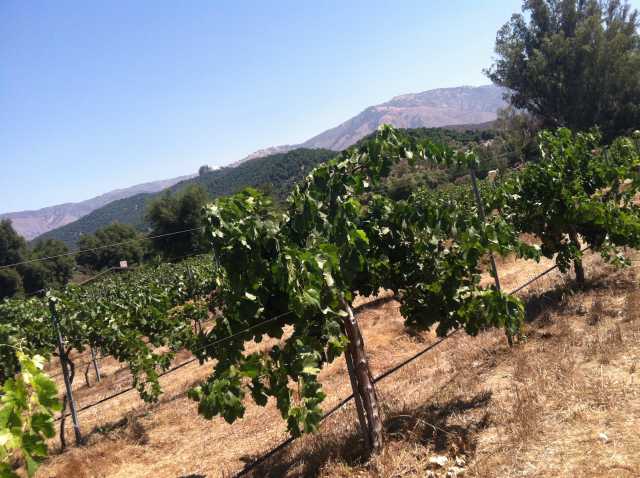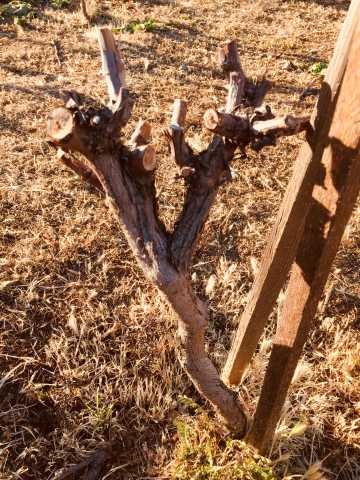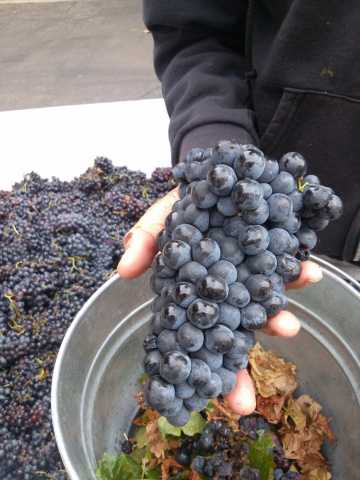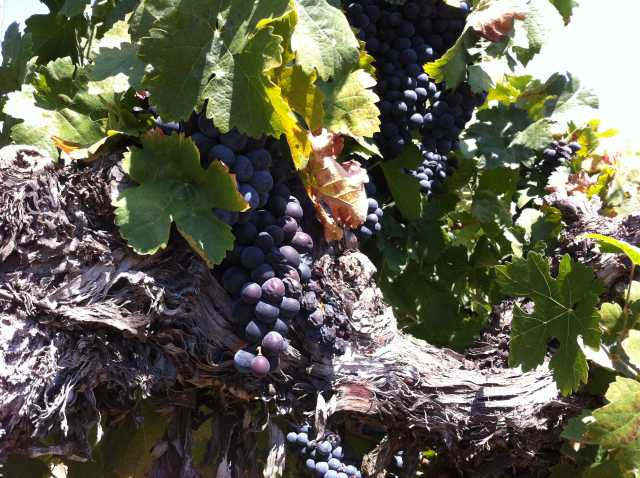Thanks for the contributions, serious and light-hearted! ![]()
We’re big fans of Gauby, but he uses ancient vine Carignan as a blending grape.
A fun visit btw, if you are ever in the region.
Bedrock released a nice one in 2012. Still available on winebid. Hoping Morgan does it again.
I received an email from Emily at J.Brix today. Here are some of her thoughts on the grape and information about the winery’s work with Carignan from San Diego County’s “McCormick Vineyard”:
"… I’ve attached a photo of McCormick Ranch Vineyard. These are the 37-year-old Carignan vines we work with to make the ‘Rougarou’. This vineyard is quite an anomaly for San Diego, where most other existing grapevines have only been planted in the last 5-10 years. McCormick Ranch was planted by a citrus-farming family as a hobby. For many years, they sold their grapes off for vinegar production, because there wasn’t a winemaking industry in San Diego. These Carignan vines have ruggedly survived fires and drought, and they produce a pretty fascinating wine. We named it after a legendary shapeshifting creature, due to its remarkable propensity to change over the course of a glass; a bottle … it’s a different wine every time you taste it.
"The vineyard’s climate here in northeastern San Diego is quite similar to the Southern Rhône. It does get hot in the summer, into the mid/upper 90s, but the vines are planted on granite, and are planted at the base of Palomar Mountain, which shades them fully during the hottest part of the day. We work with vineyards all over California; this one is usually our last to ripen in October, even though this region is warmer than anywhere else.

"I think we first learned from Randall Grahm that the French claim Carignan only starts to make a compelling wine after the vines turn 35. We’ve only made Carignan from these vines (because they’re here and old and how cool is that?!), but it does seem to get exponentially better every year, and there is a definite depth to it that feels unique. Part of that, I think, comes from the fact that it’s a San Diego old-vine Carignan, and no one really has a preconceived notion of what, exactly, that should taste like. We make it as a 100% varietal wine because it has a story that feels like it needs to be told, as an unexpected outlier survivor-vineyard in a region definitely not (yet!) known for its wine. We also often use portions for our red blend called The ‘Hornswoggle’, because Carignan always adds an element of <> that’s generally a welcome component in a blend.
"As far as the public’s general awareness, I find that people typically react in two ways when they encounter ours: 1) ‘I LOVE CARIGNAN!’ … or 2) ‘How do you pronounce this and what does it taste like?’ Then they taste it, and it’s either really their thing – and I adore watching those light-bulb moments – or it’s not. And that’s OK. Carignan as a single-varietal wine makes a gauntlet-dropping statement. We happen to really love it. It’s got a welcome place in the motley crew of varieties we make, and we plan to keep on making it every year, and aging gracefully right along with the vineyard. ![]()
"Thanks again!
"Cheers,
Emily Towe
J. Brix Wines
e: emily@jbrix.com c: 760.445.7422
298 Enterprise St., Suite D, Escondido CA 92029 "[/i]
![]()
Lodi’s Borra Vineyards is undergoing a big shift right now:
Firstly, Markus Niggli, the winemaker, has been doing his own thing with white wines evocative of his homeland for some time under the Markus line of products.
Secondly, Borra Vineyards is changing its name to Markus Wine Company. A handful of interesting reds are being offered, sourced from traditional Borra properties and other Lodi area vineyards.
Thirdly, in relation to this thread’s topic, Mr Niggli has produced a “Domo” 2015 Lodi Carignan, using fruit from the Borra “Church-Block”, a tiny property planted in 1920.
I have enjoyed the Borra Vineyards “Heritage Field Blend Red”, “Old-Vine Barbera”, as well as the Markus white blends in the past. I am absolutely ecstatic about the new line of wines (especially the “Domo” Carignane) being offered.
Mr Niggli’s email response to my questions:
• What special factors in geology, climate, etc, do you find help make Carignan a viable grape for your area of California?
MN: “We have seen that Carignan does well in warmer climates at least here in CA. Also the sandy soil seems to do well for these old plants.”
• Do you believe that old-vine Carignan is necessary for the production of top-quality fruit, or can younger vines also yield superior wines?
MN: “I believe in trends – currently Carignan is trendy, something new to explore around the word. It will take a while until it is actually appreciated what were are doing. I believe you need to be a wine fan to understand the Carignan’s position in the world of wines.”
• Markus Wines has worked with Carignan fruit from the “Borra Church-Block Vineyard”. Have you had experience with other Lodi Carignan vineyards? If so, which ones, and why have you chosen the Church-Block (and others) in particular?
MN: “Yes we also worked with the Spenker Ranch block dated back to 1900. Old trees producing great fruit.”
• Why do you think Carignan commonly proves to be more challenging to farm and produce than other Rhône-style varieties?
MN: “The grapes have a thinner skin, the older the plants are the harder it is for them to get ripe. Clusters can be tighter = more problems with water intake or/and rot.”
• Have you noticed any special qualities of Lodi Carignan compared with Carignan from other areas?
MN: “Every region has its fruit profile. I have experienced late ripening even with lower crop levels and warm temperatures, but it really produced a great product.”
• What special considerations have you discovered in producing a Carignan-dominant wine?
MN: “The freshness and it’s own character – food wine match and the acidity structure.”
• What thoughts do you have regarding the recent increase in the public’s general awareness of Carignan’s potential to create delicious varietal wines?
MN: “I think the trend eventually will move on and we go back to blending it away…”*
Markus Wine Company “Our Wines” website
Lodi Wine Blog
“The New Markus Wines Take Lodi Reds to Another Level”
by Randy Caparoso
November 9, 2017
- OUCH!

As a postscript to the prior post…
Lodi Wine Blog
“Mystery Wine for the Ages: the 2010 Borra Heritage Red”
by Randy Caparoso
September 18, 2012
"…The oldest vines going into the wine come from the family’s Church Block – growing next door to the home vineyard, a mixed bag of waist-high, gnarly, wizened, head trained Carignane and Alicante Bouschet “bushes,” originally planted around 1930 [now determined to be 1920]– so-called because up until recently (before being purchased by the Borras in 1995) it was owned by the local Catholic diocese, which seriously considered pulling up the vines and building a church."
Borra Vineyard is an interesting place…used to harvest many many tons of mixed reds from there destined for the Pleiades blend some 15 years ago and trucked them back to Bolinas. Carignane from Borra certainly had a supporting role in the Pleiades blends of years past.
I am and have been a big fan for decades… and I’ve put my vineyard where my mouth is.
This reply is hard, as I do not write up wines that I sell… Just a few facts without notes or scores about some Carignan wines I am involved with (and one I am not).
I sell a blended IGP (ex Vin de Pays) from Roussillon that I’ve been blending since the 1991 vintage. In earlier years, the typical blend was about 60/40 Carignan / Grenache. Nowadays there is less Carignan and more Grenache and Syrah available. The current release is 52/36/12 Grenache / Carignan / Syrah. I sell 5 - 10,000 cases a year. It’s moderately priced and one of my favorites in my whole book.
When my catalog included verbiage, for several years I had a whole section named ‘Carignan the Swan’.
I used to offer TWO varietal Carignans, both named ‘Expression’ (one is still in my book). One from Languedoc, one from Roussillon.
One of the ten best wines I’ve had in the past ten years was a pure varietal 2011 Carignan from Emporda, from 70 year old vines. I am still crying in my beer, because there were only ~1000 bottles made and AFAIK there is not a single one left in existence. And believe me, I’ve scoured the neighborhood. I bought a case, tried to sell some, but I pointed out to my sales team and customers that the negatives were pretty overwhelming:
- Unknown region
- Unknown varietal
- Vintage quality reputed and known to be below average in this part of the world.
- Retail ~$100
- Snake on the label
I did a blind tasting with Robert Parker about 5 years ago. The top bottling of a Chateauneuf I represent finished first of 10 wines, just ahead of 2011 Chateau Puech-Haut St Drezery ‘Reboussier’, a pure Carignan. It was also great wine. I don’t think this has ever been imported, but I own some (still in France, I believe).
When I bought my vineyard, I had 12 acres of Grenache. The next year, I bought an abandoned, adjacent vineyard and planted 3 acres of Carignan. That was in 2008. I agree wholeheartedly that older is better, but I’m usually really happy with the quality of what I’m getting right now. Yields have been all over the place. In 2014, this parcel cropped a ridiculous 3.7 tons/acre. My average is just over 2 tons/acre and in 2017 it was 1.8 tons/acre. In 2013 it was 1.3 tons/acre.
In 2014 I was able to purchase an adjoining acre of Carignan planted in the early '70’s. It is cropping ~1.5 - 2 tons/acre. I have not vinified this separately, but having tasted the grapes at harvest, I know that it is producing outstanding fruit.
However in 2017 I did harvest all of my Carignan together and right now it is ageing. I am experimenting with some oak. 35hl are in a foudre. I also have four second use barriques purchased from Chateau Chasse-Spleen. I will taste these wines in early June. It is unlikely that I will do a varietal bottling (I also have 4 barriques and a smaller foudre of Syrah, along with more Grenache in both foudre and tank), but the wines will tell me what to do.
In 2017 I planted two more acres of Carignan.
I will not give names of wines that I sell on the board, but board members can PM me if they are interested.
And now I have to hunt down some of these California wines that I’ve never heard of.
Dan Kravitz
OK, so a lot of comments, but here’s THE question:
Please list every great wine you have had that is mostly or wholly made from Carignan. Obviously definitions of ‘great’ will vary, but just list whatever is great to you.
Thanks in advance.
Dan Kravitz
Thanks for your help, Dan!!!
I doubt that you’ll be shamed for “naming names”.
I never planned to collate the information on these threads alone. These are for all board members who are interested in each respective topic.
Those domestic Carignan wines I loved the most have been (sadly) almost exclusively the last vintage available of each bottling:
• Old Vine Wine Company 2011 “Wirz Vineyard” Cienega Valley
• Joseph Swan 2012 “Côtes du Rosa” RRV
• Idlewild 2013 “Testa Vineyard” Mendocino
• The Princess and The Peasant 2014 “City of 10,000 Buddhas” Mendocino
• The Princess and The Peasant 2015 “Poor Ranch” Mendocino
Notable Mentions:
• Chateau d’Oupia “Les Hérétiques” IGP Pays de l’Herault, France (Famile ICHÉ)
• Carlisle Winery 2007 “Papera Ranch” Carignan RRV
• Cline Cellars “Ancient Vines” Carignan Contra Costa
• Populis 2015 Carignan “Reversee” Mendocino
• Domaine Lafage 2012 Carignan “Tessellae” Cotes Catalanes, France
Perpetually “On-Deck”:
• Field Recordings 2014 “Camp 4 Vineyard” Carignan Santa Ynez Valley, SBC
• Onward “Casa Roja” Carignan Contra Costa
• Onward “Hawkeye Ranch” Carignan Mendocino
• Reichwage 2016 “Mancini Vineyard” RRV
• Harrington Carignan “Lover’s Lane” Mendocino
• Populis 2015 Carignan Mendocino
• Bedrock 2012 Carignan “Bedrock Vineyard” Sonoma Valley
• Neyers 2014 Carignan “Evangelho Vineyard” Contra Costa
• Sandlands 2013 Carignan Mendocino
• Sandlands 2015 Carignan Contra Costa
• Sandlands 2015 Carignan California
• etc…
• What thoughts do you have regarding the recent increase in the public’s general awareness of Carignan’s potential to create delicious varietal wines?
MN: “I think the trend eventually will move on and we go back to blending it away…”*
Refreshing to hear such candor in the wine industry and I am sorry to agree.
Carignan doesn’t quite deserve to be compared to cilantro IMO and I happen to love cilantro. The problem-again IMHO-is that Carignan has a tendency to come across as shrill. A little more mid-palate oomph would do wonders which is why blending it with grenache or zin is a natural. Ridge has been doing carignans for years as ATP releases and again, just mho, but they have never been the most exciting Ridges and as Tom Hill likes to say, they speak more to Ridge than to the variety. Chris Brockway makes my favorite right now (all of the recent Brocs are home runs, including the Love Red). I believe I have tried 90% of those mentioned in this thread. The Populis and the Princess & the Peasant are very solid and enjoyable.
In terms of mass appeal, it needs a different name. Where would merlot be if it were not named “merlot”? Same with Pinot Grigio. They would be in the toilet where they largely belong.
So my question is - what are folks ‘looking for’ when tasting a 100% Carignane? What flavor/texture characteristics are they ‘expecting’?
Cheers.
My love of Mourvédre led to an accidental accumulation of Carignan bottlings.
As I have stated in the past, metaphorically, Mourvédre has been my “Bordeaux” and Carignan, my “Burgundy” (of sorts). Or Mourvédre : Burgundy, as Carignan : Beaujolais.
While I have been waiting for many bottles of Mourvédre to mature, my consumption of “cellar-defender” Carignan wines has increased substantially.
Carignan, just like Pinot Noir, can produce captivating, world-stopping examples of site-evocative, balanced (front-middle-finish), incredibly polished red wines. Thus my oft-repeated opinion that, like Pinot Noir, when it’s good - it’s absolutely beautiful! Likewise, when it’s not - it can be insipid. It’s a good example of a “heart-break grape”.
To my thinking, a great Carignan can easily reflect where it is grown, if the winemaking hasn’t been too heavy-handed. The best examples offer a fascinating mashup of Pinot Noir and Zinfandel flavors (earth, red-to-black berry notes, & flowery/herbal elements). Adequate acidity is almost a given in most cases, and it seems Carignan wines can deftly handle various alcohol levels.
I am not against Carbonic Maceration in the production of the wine, just as I have no opposition to the deft application of oak. It’s just very easy to go overboard with either, which will most likely destroy the very best qualities that Carignan has to offer.
…but that’s just my opinion. ![]()
to Larry Schaffer,
What I’m looking for in great Carignan:
Aromas / Flavors:
Some of Grenache - earthy, bacon, tomato, ripe red plum
Some of Mourvedre - mineral, iron, a little black fruit, very slightly floral
Some of Syrah - lots black fruit, spice, pepper, finesse, violets
Texture:
solidity, muscle, grain (more coarse than fine, but not too coarse), lots of ripe fine tannins, excellent balanced acidity, statements of climate and soil. I’ve never had one with as long a finish as I’d like, although a couple have come close.
Dan Kravitz
Thanks for your thoughts, Dan!!!
In my experience, I have detected “violets” in Mourvédre - as well as a couple of Carignan bottlings - but not in Syrah. Personal tastes, I guess!
Might it be safe to say that you have tried more European Carignan wines than Californian ones, Dan?
The 2016 Vinca Minor Carignan is very good.
Thanks to Drew and Mike Francisco for naming favorites.
Yes Drew, it’s safe to say I’ve tasted more European Carignan than French.
As per Wikipedia, acreage is apparently as follows:
France - 131,00 acres in 2009 and dropping. Probably still over 100,000, but not by much. I’ve planted 5.
Spain - 15,000 acres in 2008 and probably dropping, but not by as much.
California - 3390 in 2010 and probably stable if not growing.
But that’s not much.
I have had one unquestionably great Carignan, but it was only one vintage and 1000 bottles.
The 2011 Puech-Haut Reboussier mentioned in a previous post is on the cusp for me. I need to find the wine I own and retaste. If not great, it’s very, very close.
I will start looking for the California wines mentioned by Drew and Mike.
Dan Kravitz
Coleman from Los Pilares Wine in San Diego County responded to my email regarding Carignan. Here are his answers to my questions:
• What special factors in geology, climate, etc, do you find help make Carignan a viable grape for your area of California?
C: "We farm at altitude and that changes everything. Our vineyards sites are cooler than most of northern California. Some years [are] wetter. And always a world away from the coasts and inland valleys. [There is] lots of light. I [have] attach[ed] a photo of two-year-old carignan at 3300’elevation. I expect to be able to ripen very well. Our newest site is in a virgin alpine environment. Carignan belongs there. It is robust, drought-resistant, and very game[?]. It’s head-trained perfectly and is willing to be dry-farmed. I admire this vine and generally treat as i would grenache, pais, and graciano."

• Do you believe that old-vine Carignan is necessary for the production of top-quality fruit, or can younger vines also yield superior wines?
C: “One of the best wines I’ve ever made came from 3-year-old grenache.”
• Los Pilares has worked with Carignan fruit from the “McCormick Ranch”. Have you had experience with other Carignan vineyards? If so, which ones, and why have you chosen the McCormick (and others) in particular?
C: “McCormick is the only source of carignan in the county. We only produce wine from San Diego County fruit.”

• Why do you think Carignan commonly proves to be more challenging to farm and produce than other Rhône-style varieties?
C: "Ripening carignan without high pH numbers is challenging. [It is not a problem if you correct with acidulation but we don’t. So we are planting carignan in cooler more alpine sites in the county. I don’t really think of carignan as Rhône it’s more of a littoral that does best within 50 miles of the sea, especially in granitic and quartz soils - in our local schist."
• Have you noticed any special qualities of San Diego County Carignan compared with Carignan from other areas?
C: “The 2010 and 2011 Los Pilares carignan/grenache were extraordinary. They were very cool vintages. hence our farming strategy. Many French and Catalan winemakers in recent years have not allowed their carignan to express the finesse it is capable of displaying.”
• What special considerations have you discovered in producing a Carignan-dominant wine?
C: “The issue of ripening and pH.”
• What thoughts do you have regarding the recent increase in the public’s general awareness of Carignan’s potential to create delicious varietal wines?
C: “I applaud the public.”

Los Pilares Wine homepage
Napa Valley Register
“Natural Wine from San Diego? Los Pilares Leads the Way”
by Allison Levine
October 27, 2016